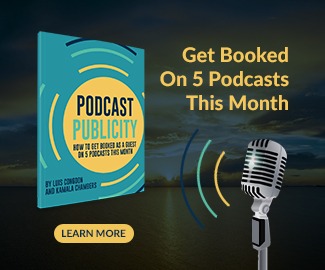True Happiness – Dr. Rick Hanson
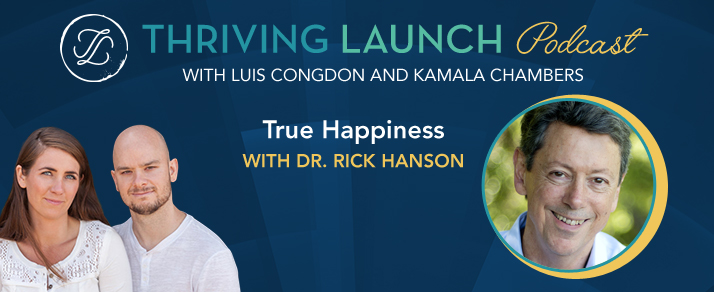
On this episode with Dr. Rick Hanson, a New York Times best-selling author, he explains the neuroscience behind true happiness, what it means, and how we can find it.
![]() When you ruminate about negative stuff, you reinforce it.
When you ruminate about negative stuff, you reinforce it.
![]() “How do you grow the good” is the key question to having true happiness.
“How do you grow the good” is the key question to having true happiness.
![]() You can slow down by taking three deep breaths in a row.
You can slow down by taking three deep breaths in a row.
![]() When you slow down, you hardwire yourself to have true happiness.
When you slow down, you hardwire yourself to have true happiness.
![]() Stop negativity as fast as you can.
Stop negativity as fast as you can.
![]() Marinade yourself in delightful experiences.
Marinade yourself in delightful experiences.
![]() Well-being is important because it fuels us for the long haul.
Well-being is important because it fuels us for the long haul.

Kamala Chambers
So happy to have you guys on this episode today because we’re going to be talking about the neuroscience of true happiness.
We are here today with Dr. Rick Hanson. He is a psychologist, a New York Times best-selling author, and he’s been a speaker at NASA, Oxford, Stanford, Harvard, and a lot of other major places and now, at Thriving Launch.

Luis Congdon
All right. Thriving Launchers, I am happy to bring on Rick Hanson today to talk about true happiness.
My first question, well, as usual, are you ready to launch Rick?

Dr. Rick Hanson
I’ve been launching all day long. So I’m still ready to talk about true happiness.

Luis Congdon
I love it.
The first question I was asking you before the show, for me is an interesting one because we’re talking about true happiness and true happiness is such a vague term to me.
I’m curious, and I know a lot of the audience members probably already know it. It might seem like a silly question, but I still want to ask from somebody who’s researched the subject.
What is true happiness? How do we measure true happiness? And how do we even know whether or not we’re genuinely happy or just induced by something that isn’t genuine, true happiness?

Dr. Rick Hanson
Those are great and profound questions and is a great place to start.
Meaning of True Happiness

Dr. Rick Hanson
Briefly, people use words in different ways. The way I use the word “True Happiness,” and researchers use that word is a synonym for well-being. There are two components to well-being. They are hedonia and eudaimonia.
Hedonia or hedonic like hedonism is the territory of having a good dinner with friends, watching a basketball game and your team is winning, delighting in your toddler taking her first steps across the living room, looking at a sunset. It’s the ordinary pleasures of life and satisfaction in finishing a load of dishes or a big project at work. That’s hedonia.
Then you have eudaimonia, which is a deeper, more profound sense of fulfillment, meaning, and purpose. About eudaimonia, I think about people who work in relief agencies or refugees, or parents walking their baby back and forth at three in the morning. They’re not particularly happy about walking their baby back and forth at three in the morning, but it’s the most meaningful and significant experience of their life. That’s eudaimonia.
So the two together, hedonia and eudaimonia give us well-being.
True Happiness And Well-Being

Dr. Rick Hanson
Well-being is important because besides feeling good, it fuels us for the long haul in life and it helps us recover from setbacks.
If deep down inside you feel like you’re running on empty, if anything gets tough, it crunches you. On the other hand, if you are running on full, even if kind of around the edges like you feel anxious or frazzled deep in your core, there’s a combination of calm strength, contentment, inner peace, and a lovingness, a warm-heartedness. That’s the essence of true happiness.
You have true happiness when you can sustain that core of well-being even when things are challenging.
It’s easy to be happy when you’re getting a mani-pedi, and they’re fluffing your hair. I’ve never had one myself.

Luis Congdon
Don’t lie. Don’t lie, Rick.

Dr. Rick Hanson
Yeah. I need chocolate and the rest of that. That’s easy.
Real Test Of True Happiness

Dr. Rick Hanson
But can you retain this core of well-being at the end of a long day or while dealing with a tricky situation with somebody else or recovering from a setback? That’s the true test.
Well-being is like the keel of a sailboat, the deeper the keel, the more that the sailboat can go out.
Dream big dreams, and swing for the fences, and sail the deep dark blue. And when the winds of life blow and bang on us, we can still recover quickly.

Kamala Chambers
Luis, I’m glad you ask that question. I am because of Rick answered it beautifully on how we can measure or understand what true happiness or well-being is. Often, it’s like this illusive sense of a feeling that we have one moment and then we don’t have the next.
I would love to hear just some tips you discovered in your research on how to create true happiness in a more sustainable way.

Dr. Rick Hanson
Right.
I’m a practical guy, and so I think you got the right question.
Creating True Happiness

Dr. Rick Hanson
First, just acknowledge that external circumstances matter. Like the people, we live with, work with, and sleep with whether there’s on a larger scale.
For example, civil society and the country that we live in or social safety need good health care and all the rest of that. Those factors matter.
Having acknowledged external factors, probably the primary sources of true happiness and well-being like courage, confidence, ambition, and this internal attitude of launching are psychological, mental factors of various kinds, inner resources, and inner strength.
Then, the question becomes “How can we grow that causes of a durable well-being even as we go through the ups and downs of life?” And those causes are inner characteristics like resilience, gratitude, compassion, mindfulness, feeling loved, and so forth.
How do you grow the good? That’s the fundamental question.
This is where neuropsychology can help us. Just a little bit is very useful, and it has to do with the idea that we grow confidence or feeling loved by others or feeling worthy as a person or develop healing from let’s say childhood trauma.
Process To Grow True Happiness

Dr. Rick Hanson
We grow anything we want to build inside through a process in a word of “warning,” which is a two stage process. Just imagine what you wish you had more like more happiness, more gratitude, more patience maybe with your teenagers, taking it less personally when your boss is grouchy, more sense of confidence or drive or motivation toward important goals.
Whatever you want to grow, you grow it in two steps.
- You have to experience it.
In a sense, you get that song playing inside your mind.
- You have to turn or transform that experience into a lasting change in the nervous system.
Otherwise, without that second step of recording the song, there’s no lasting value. There’s no healing, no growth, no learning, no development, and no true happiness.
As you go through your day, you have various beneficial experiences like feeling connected with somebody, having an insight into how to be more skillful in your relationship. You go better when you lean into the inner action rather than lean out of it, for example.
True Happiness And More Well-Being In Slowing Down

Dr. Rick Hanson
Right now, I’m looking out the window and seeing the hills in Northern California near my home.
When you have a beneficial experience or you’re just enjoying life, or you have a sense of accomplishment, slow it down.
Help your brain turn that into a lasting change of neurostructural function, which usually takes at least a few seconds and the longer, the better.
You stay with it. You savor it. You marinade in the experience. You open up to it inside yourself. Nobody needs to know you’re doing this at work. They don’t need to know you’re being a human sponge soaking these experiences into you.
But as you slow down by having two or three breaths in a row, bit by bit, synapse by synapse, you are gradually hardwiring inner strengths into yourself for both the difficult things in life and to have more well-being and to find true happiness along the way.
As you slow down, you’re hardwiring inner strengths into yourself.
>

Luis Congdon
That’s some great information that you’ve given us, and the two-step process, which I’m excited to talk about.
One of the things you said is putting on a song and practicing a song. Then, step two is bringing that song into the nervous system for long lasting change. I’m looking forward to talking about the step two.
I want to cover it briefly, but I think I know a lot of us get this idea that if I start thinking about things I want to have in my life or ways I want to feel and be, that’s like playing the song. If I start listening to music that makes me think about that thing.
If I start reading books or having conversations, or engaging in some way of entertaining or interacting with what I desire, that helps bring it into reality. Is that what I hear from you?

Dr. Rick Hanson
Right, but that’s only half of it, and that’s important just like you know.
Part one. In most self-help, it focuses on this part. Get a good state of mind going. Like a useful perspective, an inspirational idea or maybe a good feeling in your body.
Turning The Good State Of Mind To Have True Happiness
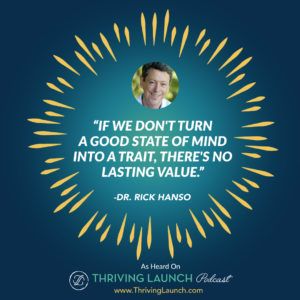

Dr. Rick Hanson
That’s the dirty little secret of lots of self-help, in coaching, in psychotherapy.
I’m speaking of myself here, raising kids, mindfulness training, and human resources development.
We’re good at helping people have beneficial experiences, but we’re lousy at helping them be changed for the better as a result.
That’s to me, where the fantastic opportunity is. You could steepen people’s average growth curve or their learning curve as they go through their day or as they go through a day of work.
Let’s say, as a manager, we’re trying to help people become more productive, creative, and cooperative with each other, motivated, increase moral and so forth. If we want to do that, part of the process is helping people have valuable experiences of those things. But then, we need also to help them internalize those experiences as some lasting change.
That’s why I think that it’s humbling to ask the question, “Okay. What can I do as I go through my day?” Or “What can I do as I help others?” As a therapist or a coach or a manager or a teacher or parent, what can I do to help others maximize their conversion rate of states to traits or of experiences to lasting change for the better in the brain?

Kamala Chambers
I’m interested in hearing from you one of the most surprising things you’ve discovered in your research about true happiness. Is there anything that you can think of that comes to your mind?

Dr. Rick Hanson
Two things just blow my mind, and they blow my mind because I do they myself even though I’m an expert on this stuff.
- The brain’s negativity bias.
Negativity Bias And True Happiness

Dr. Rick Hanson
We’ve got a brain that’s like Velcro for bad experiences but Teflon for good experiences.
Even though learning from our good experiences is how to grow good stuff inside ourselves like resilience, gratitude, compassion, confidence, and true happiness. That’s the first thing.
We have this negativity bias because our ancient ancestors needed both to avoid sticks but get carrots too. Carrots are like food and so forth.
Here’s the difference.
If you don’t get a carrot today, you’ll have a chance to one tomorrow. But if you fail to avoid that stick today, that predator, that aggression inside your band or between bands, whack! No more carrots forever.
So routinely, we scan for bad news out in the world and your body and mind, and we overreact to it and fast track the whole package into memory.
If ten things happen in a day in your relationship, nine are positive, and one is negative, what’s the one you obsess about as you’re falling asleep?
If you get a performance review at work and your boss tells you ten things, nine are positive, and one is room for improvement. What’s the one you think about for the rest of the day? It’s usually the negative one.
Then, the brain is also progressively sensitized to the negative through the stress hormone cortisol that is also released when we’re just irritated, or frazzled, or frustrated, or driven or we feel anxious or hurt. That’s takeaway number one.
We’ve got this negativity bias that made sense back in the Stone Age, and it might occasionally make sense today if people are working in a combat zone or growing up in a combat zone or what feels like a combat zone.
Most of the time having a brain that’s like Velcro for the bad but Teflon for good makes us harder to be successful at work and find true happiness and builds conflicts and vicious cycles with other people.
Ignore Negativity And Focus On True Happiness

Dr. Rick Hanson
One of the surprising takeaways for me was to be much more respectful as it were of the power of the dark side of the force. What it means is much more kind of respectful of not ruminating about negative stuff.
When we’re ruminating about negativity, heavy hashing resentments in our mind, beating ourselves up, or repeatedly going over conversations with other people with hurt feelings, we are reinforcing that negativity. Our brain is very spongy for that.
Pull out of that red zone experience as fast as you can and start shifting gears so you can move back more into the green zone mind.
That was takeaway one.
Beneficial Experiences And True Happiness

Dr. Rick Hanson
Take away two is it’s striking how quickly people blow by valuable experiences even in our so-called pleasure seeking culture. They finish a tricky email, then, go on to the next one. They have a beautiful moment with a friend or a partner or a child. Whoosh! They’re on to the next thing. They have some real insight or thought that gives them some sense of relief.
I think part of blowing by beneficial experiences rapidly is built into the culture. We have a very ADD culture. We’re constantly being stimulated and chasing the next thing.
Also, I think some of that comes from this fear that if we just marinade in the present moment that’s beneficial, we’ll lower our guard and lose our edge but that’s not true.
When you marinade in the moment of whatever is beneficial which usually a relatively mild experience, but it’s authentic, it’s a time of gratitude, of feeling strong, of determination, and a sense of reward from doing a workout or doing the right thing in life in some way. Those experiences are good for us to create true happiness.
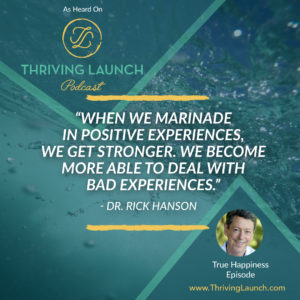

Dr. Rick Hanson
As we relish, savor, soak in, and take in the good of these common beneficial experiences, we can also keep our eyes on the prize. Also, we can be vigilant for some threat coming in. In other words, it’s not either-or.
Disengage in the negative as fast as you can.
When life serves you that big dish right in front you, brandish it.

Luis Congdon
That’s great.
Inherited Mindset That Overlooks True Happiness

Luis Congdon
The first example you’re talking about how our minds work. Also, that there’s this tendency and it comes from inherited physiological responses we have, a propensity to look at the bad things happening or try to avoid the bad things than focusing on true happiness.
We’ve been programmed by nature to mitigate the bad as much as possible. We look for the bad so that we can minimize it, but that creates a mind or a system in your body that is always looking for the bad.
Now, that mind doesn’t help. Not in today’s age. If you are on a battlefield like you were saying, that’s great.
That makes me wonder. How do we start training our minds not to do that as much? Is that even possible? Is that something we can do? Is that humanly possible if physiologically DNA hardwire?
It’s in our system to look for the sticks, to look for the possible bad things that could happen and the things that are happening or will happen that are bad. There’s this kind of just focus on the bad.

Dr. Rick Hanson
Right.

Luis Congdon
So one, there is a benefit to try to look for the good. How do we do that?

Dr. Rick Hanson
Yeah. Exactly right.

Luis Congdon
The second piece you talked about was interesting to me too. It’s one that I want to take a little time to dive in as well.
True Happiness In Acknowledging Wins

Luis Congdon
One of the things I heard you talking about is marinating in the good and acknowledging the wins we have. I know that’s something I don’t tend to do enough.
Today has been a pretty active day, but just in a conversation with my family and with Kamala, I know some of the things that have been on my mind is “I want to get here. I’m excited to get to this place. It’s always a little bit ahead of me.”
And yet, when I heard you say that, I thought, yesterday evening, I spent four or five hours with my little nephews. They’re incredible. I had an enjoyable evening, excellent meal, played with them and walked the dogs today.
Also, I’m almost done writing this book I’ve been working on for months and sent out emails, and I just thought, “Whoa! It’s been a successful day.” But I have not taken any time today to reflect on the success or marinade in the fact that I’ve done that. Instead, it’s been one thing and then, thinking of this bigger goal.
And so, I’m unsatisfied with the steps I’ve taken and more just focus on this bigger goal. It’s just kind of this loop. I don’t celebrate, or today, I didn’t. I didn’t celebrate those little things, and then I was focused on “I want to get there, but I’m not getting there. I need to get there, and if I don’t get there, then bad things can happen.”
It’s this loop. As I hear you talk, it’s like, “Okay. How do we get out of that loop?”

Dr. Rick Hanson
Right, it’s real deep stuff.
Creating True Happiness Through Doing And Being

Dr. Rick Hanson
Well, one way to do it is the ideal point of doing and being. We tend to do a lot just like you’re saying. We do this, do that, accomplish this, perform that to be something like to be happy, be fulfilled, be someone who feels appreciated by other people.
The problem is if we do it the way we usually do, which is always doing in a being as just one step away, we never get to being. We never find true happiness.
The whole point of doing is to get to being. But all that doing makes it impossible to get to being. It is perverse. So the solution is to start to from being. Flip it around.
In other words, come from being, already happy, already loved, already peaceful inside by which we do, do, do, do, do. It’s a simple switch.
Coming from being is a simple flip where you say “What it would be like to establish inside myself a kind of base one or a fundamental serve core of feeling already contented, full, and balanced as I enter the next moment? That is sustaining mindfulness, staying in the present, staying in the now, feeling already stable in my core, strong inside as I lean into life. That feels different. That’s the first point.
The second thing is people vary in their negativity bias. Some people, just by nature, tend to be more aversive. They’re more focused on what’s unpleasant. They learn faster from it. So we start there, and then life happens, and people can increase their negativity bias. They can become more like Velcro for the bad if they had a hard childhood or dealing with a high-stress situation because stress sensitizes the brain and increases the negativity bias.
Take In More Good To Have True Happiness

Dr. Rick Hanson
In either case, they’re actually as emerging research that shows there was repetition. When you think about how many times we took the bad, it’s a lot. We need to balance it by taking in the good 10,000 times, but it’s just 10 seconds at a time.
Research shows, repeatedly registering rich, embodied, rewarding experiences that are beneficial of accomplishing something through a course of the day, feeling connected with other people in good ways, having wholesome pleasures of various kinds, feeling good inside.
Anyone of those but all of those over the course of the day, repeatedly taking in the good a dozen or more times a day will gradually sensitize the brain.
Amygdala’s Role in Having True Happiness

Dr. Rick Hanson
In a title of a funny but very profound research paper on the neuropsychology of all this, we can over time develop what’s called a Joyful Amygdala. That’s a part of the brain or two of them that is tracking continuously how relevant experiences are.
The amygdala on average tends to be oriented toward the negative. That’s the negativity bias. But with practice, we can turn that amygdala around, so it becomes more like Velcro for the good and Teflon for the bad. We’ll still see the real threat. We won’t become stupid. We won’t run red lights or ignore serious threats, but we can approach life with more efficiency and rapidity with which we learn from positive experiences.

Kamala Chambers
I loved what you’re saying and sharing.
Before we go, what is the number one thing you want the Thriving launchers to walk away with? What’s one of the most important things about your work on finding true happiness?
Develop A Positive Habit To Find True Happiness

Dr. Rick Hanson
The first of the two is to know what muscle you’re growing these days.
What I mean is pick one thing or maybe two things that you’re trying to develop inside these days.
Maybe like Luis was saying you’re trying to develop more of an attitude of slowing down and taking in good stuff along the way. You’re trying to learn to do that. It’s a new habit. It’s a positive pattern.
What is that positive habit or inner strength you’re particularly focused on these days? Maybe it’s what would help to deal with the stressful situation at work, or maybe it’s what we’ve compensated for and soothe, and eventually, heal some leftover issue from a previous relationship or your childhood like underlying feelings of inadequacy. For example, those would be addressed by repeatedly taking in experiences of self-worth.
Maybe it’s somebody who’s got a long-standing sense of anxiety. They’re nervous about things. For that person, the key muscle to grow inside or the critical resource to develop inside would be feelings of calm or feeling I’m safe and protected deep in their core to balance that anxiety.
Maybe it’s someone who has long-standing issues with chasing pleasure. That person would be aided by growing a more of a sense of feeling contented already.
Whatever it might be, what are you trying to develop?
Frankly, early in my marriage especially after kids came along, one thing I tried to help land inside myself was I needed to take my wife into account in all kinds of new ways once we had children, for example.
So know what you’re trying to grow. That’s my suggestion.
True Happiness And The Power Of Little Opportunities
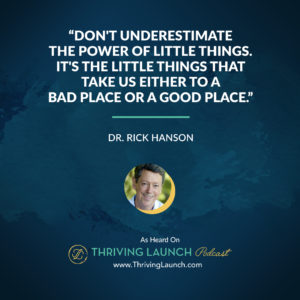

Dr. Rick Hanson
Every day, even in most terrible life in the world, the harder the life, the more important it is to do what I’m talking about here, which is to look for little authentic opportunities to take in the good along the way.
Taking in the good along the way fill ourselves up over the course of a single day from the inside out.
Don’t underestimate all those little opportunities.
Think not likely of good saying it will not come to me. Drop by drop is the water pot filled. Likewise, the wise one gathering it little by little fills oneself with good.

Kamala Chambers
We’ve been here with Dr. Rick Hanson talking about how to fill ourselves with good, really, the neuroscience behind true happiness.
I encourage you all to go out today and practice some of these fantastic tips Dr. Rick Hanson has shared with us so we can all have true happiness.
Keep thriving everyone.


